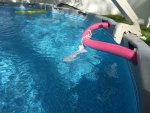I don't know if this is the right place to post this question. As the title says, my above ground pool (Intex Ultra Frame 12'x24'x52'') does not come with a skimmer and I was wondering how I could add powder chemicals, like cyanuric acid, to my pool to prevent damage on the liner. I was reading that I could literally tie a sock in front of a return and let it dissolve there. How successful is that method?
Thanks in advance.
Thanks in advance.


